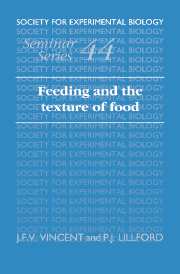Book contents
- Frontmatter
- Contents
- List of contributors
- Introduction
- Mechanical and fracture properties of cellular and fibrous materials
- Texture of plants and fruits
- Measuring meat texture and understanding its structural basis
- Food processing by mastication in cyprinid fish
- Quantitative aspects of the relationship between dentitions and diets
- The control of movements and forces during chewing
- The basic mechanics of mastication: man's adaptive success
- Integrating texture and physiology – techniques
- Brittle textures in processed foods
- The control and generation of texture in soft manufactured foods
- Texture and acceptability of human foods
- Index
Food processing by mastication in cyprinid fish
Published online by Cambridge University Press: 14 January 2010
- Frontmatter
- Contents
- List of contributors
- Introduction
- Mechanical and fracture properties of cellular and fibrous materials
- Texture of plants and fruits
- Measuring meat texture and understanding its structural basis
- Food processing by mastication in cyprinid fish
- Quantitative aspects of the relationship between dentitions and diets
- The control of movements and forces during chewing
- The basic mechanics of mastication: man's adaptive success
- Integrating texture and physiology – techniques
- Brittle textures in processed foods
- The control and generation of texture in soft manufactured foods
- Texture and acceptability of human foods
- Index
Summary
Aquatic food is diverse in size, shape, location, motility, chemical and mechanical properties (Nikolsky, 1963) as are adaptations in fish to capture and process food. Unlike mammals, fish have no claws, so food collection is performed entirely by the oropharyngeal apparatus. In some, mainly predatory, fish the mouth is specialised for fast and voluminous suction. In others, mainly planktivorous fish, prey capture proceeds by overswimming, and suction plays a minor role (van Leeuwen & Muller, 1984; Sibbing, 1991). The complex of muscles, bones and ligaments composing the suction-pressure pump of the respiratory apparatus (cf. Ballintijn, 1969) eventually performs a whole range of diversified feeding actions. By accurate timing of volume changes in the oral, buccal, pharyngeal and opercular cavities and by differential operation of the oral and opercular valves, carp can perform as many as ten stereotyped patterns of movement, each serving a particular role in food processing (Sibbing, Osse & Terlouw, 1986; and see Fig. 1). These patterns are: (1) particulate intake or (2) gulping for intake, (3) rinsing, (4) spitting or (5) selective retention for sorting food from non-food, (6) transport, (7) loading, (8) crushing, (9) grinding and (10) deglutition or swallowing. In addition, size-selective retention of small food particles (sieving) is effected by the branchial sieve (Zander, 1906; Hoogenboezem et al., 1990), if such particles are abundant. Whereas size, location and motility of food are crucial factors for capture strategies, taste, degree of mixture with non-food and size are determinants in sorting out food from non-food (Sibbing et al., 1986). But how do fish cope with the highly varied mechanical properties of food?
- Type
- Chapter
- Information
- Feeding and the Texture of Food , pp. 57 - 92Publisher: Cambridge University PressPrint publication year: 1991
- 10
- Cited by



